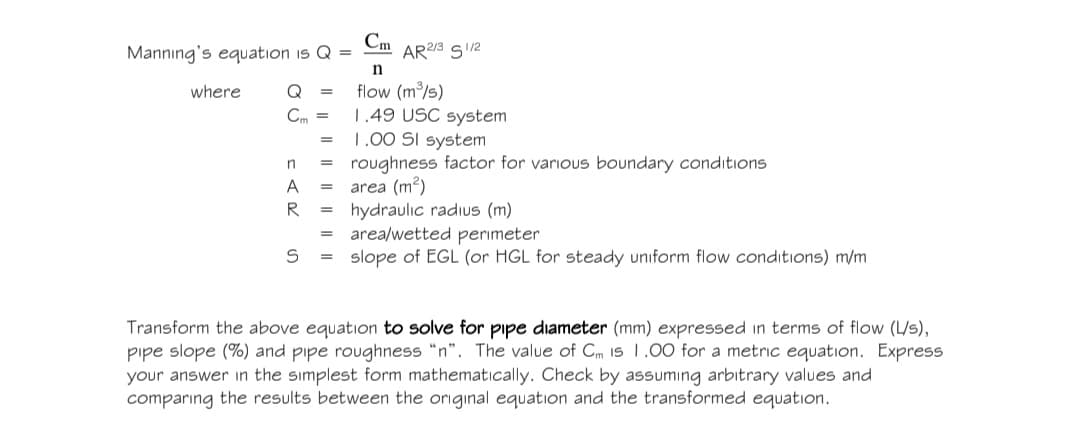Manning's equation is Q = where Cm AR 2/3 1/2 n Q = Cm = = flow (m³/s) 1.49 USC system 1.00 SI system roughness factor for various boundary conditions area (m2) hydraulic radius (m) n = A = R == = S = slope of EGL (or HGL for steady uniform flow conditions) m/m area/wetted perimeter Transform the above equation to solve for pipe diameter (mm) expressed in terms of flow (L/s), pipe slope (%) and pipe roughness "n". The value of Cm 1s 1.00 for a metric equation. Express your answer in the simplest form mathematically. Check by assuming arbitrary values and comparing the results between the original equation and the transformed equation.
Manning's equation is Q = where Cm AR 2/3 1/2 n Q = Cm = = flow (m³/s) 1.49 USC system 1.00 SI system roughness factor for various boundary conditions area (m2) hydraulic radius (m) n = A = R == = S = slope of EGL (or HGL for steady uniform flow conditions) m/m area/wetted perimeter Transform the above equation to solve for pipe diameter (mm) expressed in terms of flow (L/s), pipe slope (%) and pipe roughness "n". The value of Cm 1s 1.00 for a metric equation. Express your answer in the simplest form mathematically. Check by assuming arbitrary values and comparing the results between the original equation and the transformed equation.
Chapter2: Loads On Structures
Section: Chapter Questions
Problem 1P
Related questions
Question

Transcribed Image Text:Manning's equation is Q =
where
Cm
AR 2/3 1/2
n
Q =
Cm =
=
flow (m³/s)
1.49 USC system
1.00 SI system
roughness factor for various boundary conditions
area (m2)
hydraulic radius (m)
n
=
A
=
R
==
=
S
=
slope of EGL (or HGL for steady uniform flow conditions) m/m
area/wetted perimeter
Transform the above equation to solve for pipe diameter (mm) expressed in terms of flow (L/s),
pipe slope (%) and pipe roughness "n". The value of Cm 1s 1.00 for a metric equation. Express
your answer in the simplest form mathematically. Check by assuming arbitrary values and
comparing the results between the original equation and the transformed equation.
Expert Solution
This question has been solved!
Explore an expertly crafted, step-by-step solution for a thorough understanding of key concepts.
Step by step
Solved in 1 steps with 4 images

Recommended textbooks for you


Structural Analysis (10th Edition)
Civil Engineering
ISBN:
9780134610672
Author:
Russell C. Hibbeler
Publisher:
PEARSON

Principles of Foundation Engineering (MindTap Cou…
Civil Engineering
ISBN:
9781337705028
Author:
Braja M. Das, Nagaratnam Sivakugan
Publisher:
Cengage Learning


Structural Analysis (10th Edition)
Civil Engineering
ISBN:
9780134610672
Author:
Russell C. Hibbeler
Publisher:
PEARSON

Principles of Foundation Engineering (MindTap Cou…
Civil Engineering
ISBN:
9781337705028
Author:
Braja M. Das, Nagaratnam Sivakugan
Publisher:
Cengage Learning

Fundamentals of Structural Analysis
Civil Engineering
ISBN:
9780073398006
Author:
Kenneth M. Leet Emeritus, Chia-Ming Uang, Joel Lanning
Publisher:
McGraw-Hill Education


Traffic and Highway Engineering
Civil Engineering
ISBN:
9781305156241
Author:
Garber, Nicholas J.
Publisher:
Cengage Learning